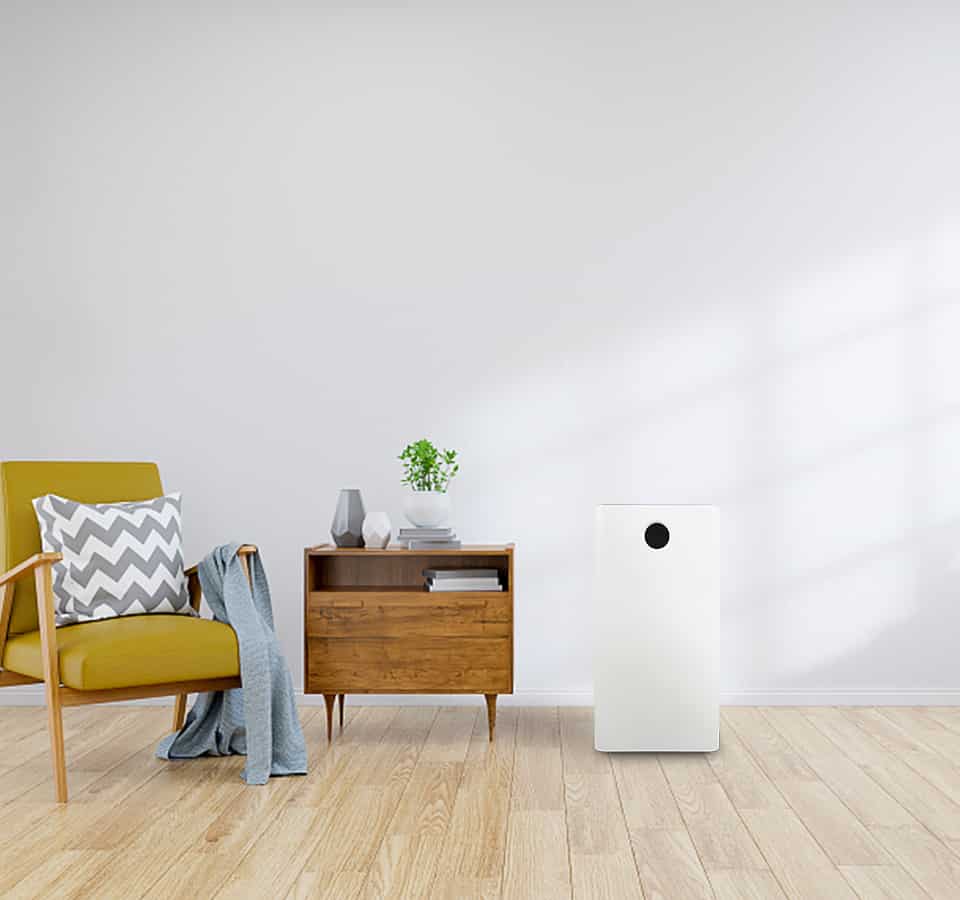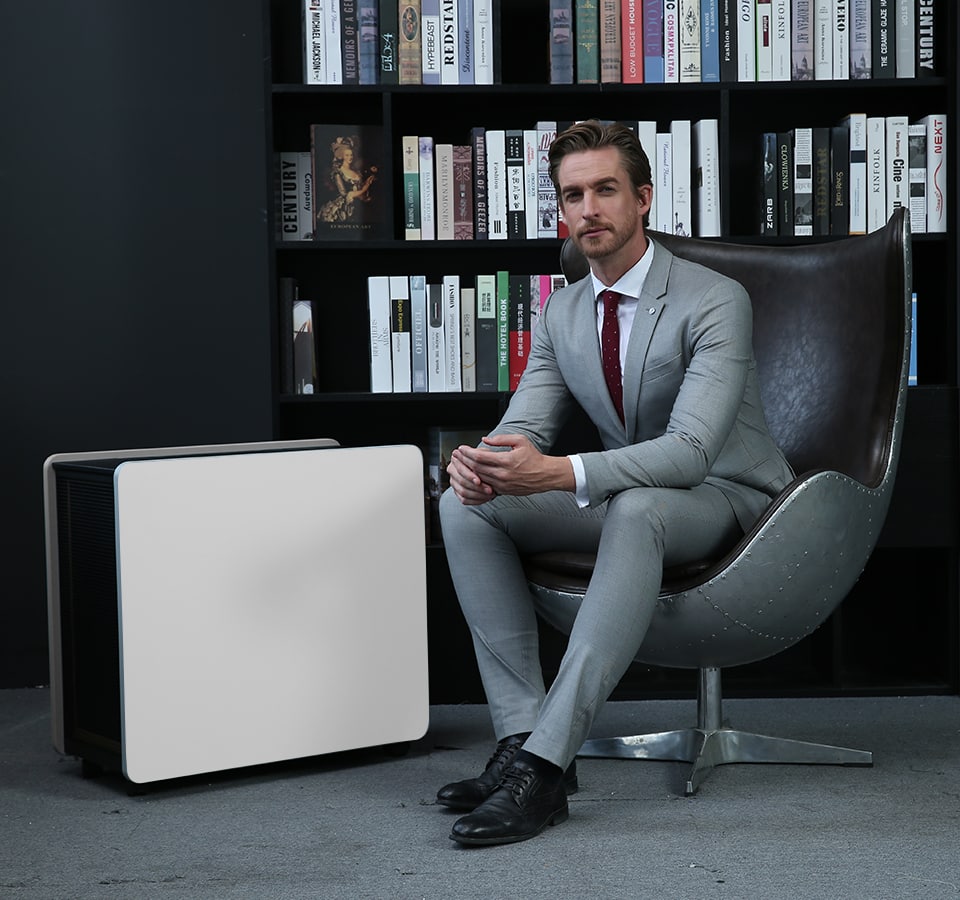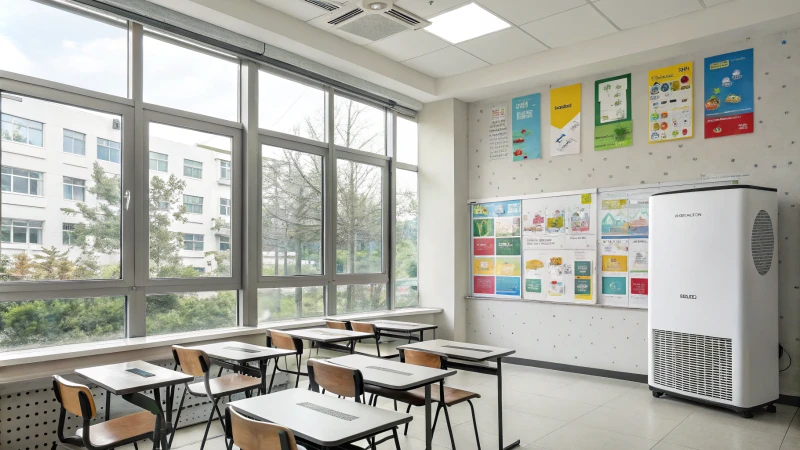
Denken Sie an den Moment in der Schule, als sich alle einfach nur entspannen und auf das Lernen konzentrieren wollten.
Der beste Luftreiniger für Schulen muss starke Filter und eine leise Funktion haben. Außerdem sollte er so konzipiert sein, dass Kinder ihn nicht berühren können. Die Modelle von HisoAir sind eine gute Wahl. Ihre fortschrittliche Technologie ist sehr beeindruckend. Sie lassen sich leise an Wänden oder Decken anbringen. Ideal für Schulen.
Wenn ich an meine Schulzeit zurückdenke, hat uns der Lärm wirklich vom Lernen abgelenkt. Die richtigen Luftreiniger sorgen nicht nur für saubere Luft, sondern auch für ruhige Räume. Bei der Auswahl eines Luftreinigers für ein Klassenzimmer muss man darauf achten, wie gut er funktioniert, vor allem in großen Räumen, in denen frische Luft für die Gesundheit sehr wichtig ist. Auch die Größe und das Geräusch des Luftreinigers spielen eine Rolle. Ein leiser Luftreiniger, der die Luft gut reinigt, verändert das Klassenzimmer sehr.
Manche Schüler lieben es, alles anzufassen, was sie sehen. Aus diesem Grund sind Wand- oder Deckengeräte sehr hilfreich. Diese Geräte befinden sich außerhalb der Reichweite, so dass sie ungestört arbeiten können. Unternehmen wie HisoAir kennen diese Bedürfnisse. Sie bieten Lösungen an, die gute Leistung mit intelligentem Design verbinden. HisoAir entwickelt Luftreiniger, die gut funktionieren und unbemerkt bleiben - wahrscheinlich die beste Wahl für Schulen.
Klassenräume benötigen Luftreiniger mit über 300 CFM.Wahr
Klassenräume sind oft größer als 1000 Quadratmeter und benötigen 5-6 Luftaustausche.
HisoAir Luftreiniger sind für Schulen nicht geeignet.Falsch
HisoAir bietet leise und leistungsstarke Luftreiniger, die ideal für Schulen sind.
Welche Merkmale sollten Sie bei einem Luftreiniger für Klassenzimmer beachten?
Haben Sie schon einmal ein Klassenzimmer betreten und festgestellt, dass sich die Luft alt anfühlt? Diese abgestandene Luft ist nicht nur unangenehm, sondern stellt auch ein Gesundheitsrisiko dar.
Wählen Sie einen Luftreiniger mit den wichtigsten Eigenschaften für ein Klassenzimmer. Zu den wichtigen Faktoren gehören eine hohe Luftfilterrate (Clean Air Delivery Rate, CADR) und ein niedriger Geräuschpegel. Eine echte HEPA-Filterung garantiert saubere Luft. Sichere Installationsoptionen sind von großer Bedeutung. Diese Entscheidungen tragen dazu bei, einen friedlichen Ort zum Lernen zu schaffen.
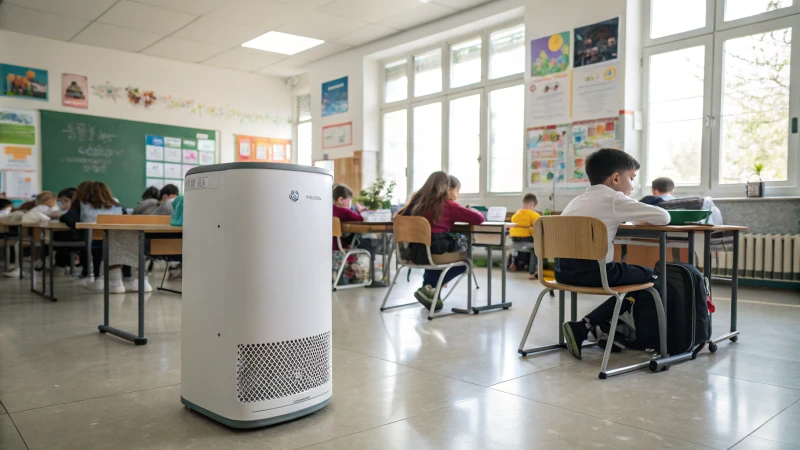
Die Bedeutung der Luftreinhalterate (CADR)
Ich weiß noch, wie ich zum ersten Mal das Klassenzimmer meiner Tochter betrat. Die Luft fühlte sich schwer an. Die geschlossenen Fenster hielten die Kälte draußen, aber man konnte spüren, wie viele Atemzüge im Raum verweilten. Dadurch wurde mir klar, wie wichtig eine gute Luftqualität ist. Kinder verbringen viel Zeit in diesen Räumen.
Das erste, was ich gelernt habe, war die Clean Air Delivery Rate (CADR). Diese Rate gibt an, wie viel saubere Luft ein Luftreiniger pro Minute liefert. Große Räume wie Klassenzimmer brauchen dies. Räume, die größer als 1.000 Quadratmeter sind, benötigen eine CADR von über 300 CFM, damit die Luft frisch und leicht zu atmen bleibt.
Filtersysteme: Echte HEPA und mehr
Ein weiterer wichtiger Faktor ist das Filtersystem. Echte HEPA-Filter sind erstklassig und fangen 99,97% winzige Partikel bis zu einer Größe von 0,3 Mikrometern ab, was zum Abfangen von Allergenen und Viren beiträgt.
| Filter Typ | Funktion |
|---|---|
| Echte HEPA | Fängt winzige Partikel ein |
| Aktivkohle | Entfernt Gerüche und VOCs |
| Vorfilter | Fängt größere Partikel auf |
Einige Luftreiniger verwenden auch Aktivkohlefilter, um Gerüche und Chemikalien zu beseitigen, was ein großer Vorteil ist.
Geräuschpegel: Leise bedeutet Konzentration
Der Versuch, sich bei Hintergrundlärm zu konzentrieren, ist schwierig. In Klassenzimmern ist der Geräuschpegel wichtig. Ich habe festgestellt, dass Luftreiniger mit einem Geräuschpegel unter 50 Dezibel am besten geeignet sind, um die Konzentration in Bildungseinrichtungen aufrechtzuerhalten.
Sicherheits- und Installationsüberlegungen
Die Sicherheit ist mir sehr wichtig. Die Kinder könnten das Gerät berühren, daher ist die Anbringung von Luftreinigern an Wänden oder Decken sehr sinnvoll. Das spart Platz und schafft eine sicherere Atmosphäre für alle, wovon Kinder und Lehrer gleichermaßen profitieren.
Zu beachtende Zusatzfunktionen
Moderne Luftreiniger verfügen über zusätzliche Funktionen wie Luftqualitätssensoren und automatische Modi, die die Einstellungen des Luftreinigers an die aktuellen Bedingungen anpassen und so für Erleichterung und Komfort sorgen - etwas, das für jeden Lehrer unglaublich nützlich ist.
Luftreiniger für Klassenzimmer benötigen über 300 CFM, um wirksam zu sein.Wahr
Um 5-6 Luftwechsel pro Stunde in großen Räumen zu erreichen, werden 300 CFM benötigt.
Die Decibel Cancellation™ von HisoAir ist eine Technologie zur Lärmreduzierung.Wahr
Decibel Cancellation™ reduziert den Lärm und verbessert die Lernumgebung.
Wie wirkt sich der Lärmpegel auf Lernumgebungen aus?
Haben Sie schon einmal in der Nähe einer Baustelle gelernt? Es ist ähnlich wie das Lernen bei einem lauten Rockkonzert. Der Lärm lenkt ab und frustriert. Für Schüler, die sich konzentrieren wollen, ist das eine echte Herausforderung.
Der Lärmpegel beeinträchtigt Lernräume erheblich. Er stört die Konzentration und das Verständnis. Hoher Lärm verringert die akademische Leistung. Der Stresspegel steigt. Strategien zur Lärmkontrolle helfen wirklich. Sie verbessern die Lernergebnisse.
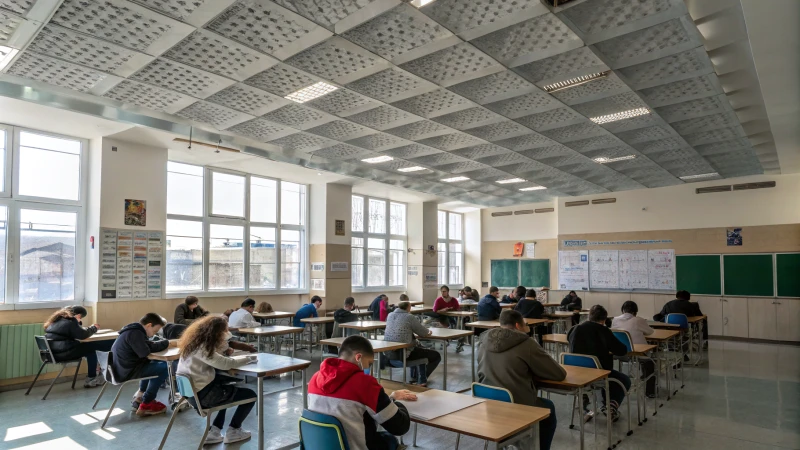
Die Wissenschaft hinter der Lärmbelästigung
Eines Tages saß ich in der Klasse und versuchte, einer wichtigen Unterrichtsstunde zuzuhören. Verkehrsgeräusche und Menschen, die sich in der Nähe eines Fensters unterhielten, waren lauter als der Lehrer. Es fühlte sich an, als würde man ein Flüstern im Sturm hören. Die Forschung zeigt, dass zu viel Lärm, wie Hintergrundgerede1 oder Verkehr, führt zu geistiger Überlastung. Den Schülern fällt es schwer, den Unterricht zu verstehen und sich Dinge zu merken. Eine ruhigere Umgebung fördert die Konzentration und den Lernerfolg.
Psychologische Auswirkungen von Lärm im Klassenzimmer
Lärm verursacht echten psychischen Stress. Ich habe erlebt, dass sich Schüler wegen lauter Klassenräume gestresst und ängstlich fühlen. Ich habe es auch schon gespürt - einen dichten geistigen Nebel. Ein hoher Lärmpegel schadet der geistigen Gesundheit und kann sogar körperliche Probleme verursachen, die das Lernen verhindern. Mit schalldämpfenden Lösungen wie Teppichen, Vorhängen oder Akustikpaneelen lassen sich diese Auswirkungen abmildern.
Bewertung der Akustik im Klassenzimmer
Haben Sie schon einmal wegen einer lauten Klimaanlage im Klassenzimmer geschrien? Das ist überhaupt nicht lustig. Es ist sehr wichtig zu prüfen, wie sich der Schall in einem Klassenzimmer ausbreitet. Eine gute Signal-Rausch-Verhältnis2 hilft den Schülern, den Unterricht deutlich zu hören. Mit Geräten wie Dezibelmessern kann der Umgebungslärm gemessen werden, was den Lehrkräften hilft, problematische Bereiche zu erkennen.
| Lärmquelle | Potenzielle Auswirkungen | Strategie zur Risikominderung |
|---|---|---|
| Verkehrsgeräusche | Lenkt die Schüler ab | Doppelt verglaste Fenster einbauen |
| Chatter im Klassenzimmer | Reduziert die Aufmerksamkeit | Strategische Sitzordnung |
| HVAC-Systeme | Verursacht Tonstörungen | Verwenden Sie lärmarme Geräte |
Praktische Strategien zur Reduzierung von Lärm im Klassenzimmer
Erstellen von Ruhezonen3 in Schulen verändert alles. In diesen Bereichen können die Schüler arbeiten, ohne unterbrochen zu werden. Sound-Masking-Systeme sorgen für eine gleichmäßige Geräuschkulisse, die störende Geräusche ausblendet und die Konzentration erhält.
Das Verständnis der Auswirkungen von Lärm auf das Lernen hilft Lehrern, bessere Orte für Schüler zu schaffen. Die Lösung dieser Probleme verbessert nicht nur das Lernen, sondern verändert die Bildung wirklich zum Besseren.
In Klassenzimmern werden Luftreiniger mit mehr als 300 CFM benötigt, um effizient zu sein.Wahr
In Klassenzimmern sind leistungsstarke Luftreiniger für einen ausreichenden Luftaustausch erforderlich.
Wandmontierte Luftreiniger sind für Klassenräume ungeeignet.Falsch
An der Wand montierte Luftreiniger verhindern Störungen durch Schüler und erhöhen die Sicherheit.
Warum ist die Platzierung von Luftreinigern für Schulen wichtig?
Ich erinnere mich an die Zeit, als meine Schule ihren ersten Luftreiniger erhielt. Zuerst war ich skeptisch. Als ich die Bedeutung des Standorts verstand, änderte sich für mich alles.
Die richtige Platzierung von Luftreinigern in Schulen ist wichtig für eine bessere Raumluftqualität. Luftreiniger sollten geschickt platziert werden. Das hilft ihnen, die Luft gut zu reinigen. Sie helfen, schädliche Partikel zu entfernen. Die richtige Positionierung verbessert den Luftstrom. Der Luftreiniger deckt mehr Fläche im Raum ab. Allergene und Krankheitserreger werden wirksam reduziert.
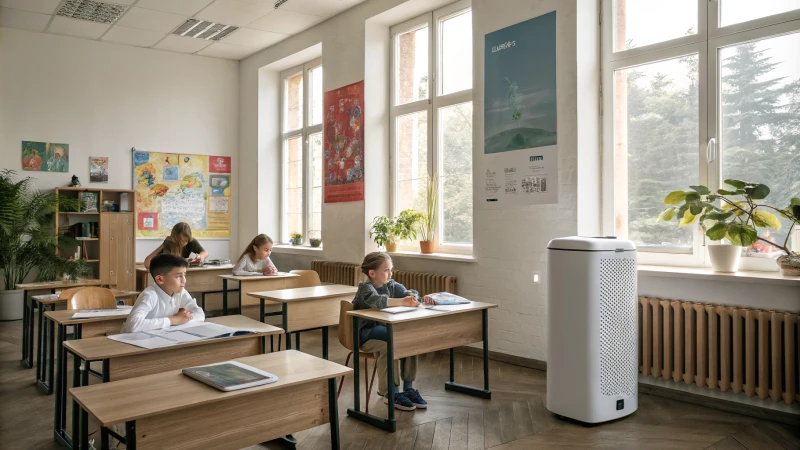
Verbesserung des Luftstroms und der Deckung
Wenn ich an meine Zeit in einer stark frequentierten Schule zurückdenke, wird mir klar, warum es wichtig ist, die Raumdynamik zu kennen. Nehmen Sie ein Klassenzimmer mit über 1000 Quadratmetern. Ohne eine geschickte Platzierung könnte selbst ein erstklassiger Luftreiniger nicht gut funktionieren. Früher glaubte ich, ein Luftreiniger würde ausreichen. Aber der Standort ist entscheidend. Ein leistungsstarkes Gerät mit über 300 CFM ist erforderlich, um 5-6 Luftwechsel pro Stunde zu erreichen.
Es ist wichtig, den Luftreiniger in der Mitte zu platzieren. Das ist so, als würde man einen Ventilator an der richtigen Stelle aufstellen, um einen Raum gleichmäßig zu kühlen. Verstecken Sie die Luftreiniger nicht hinter Möbeln oder in Ecken; das ist so, als würden Sie versuchen, ein Flüstern inmitten von Lärm zu hören. An der Wand montierte Geräte schützen sie geschickt vor neugierigen Händen und sind auch weiterhin effektiv.
Bedenken hinsichtlich des Lärmschutzes
Lärm stört den Unterricht leise, aber sicher. Ich erinnere mich an die Schwierigkeit, sich inmitten von Gerätegeräuschen zu konzentrieren. Technologien wie Decibel Cancellation™ sind wertvoll, weil sie die Reinigungsgeräte sehr leise machen.
| Merkmal | Nutzen Sie |
|---|---|
| Wandmontiertes Design | Verhindert Manipulationen |
| Decibel Cancellation™ | Reduziert Lärm |
Sicherheit und Schutz
Die Sicherheit in Schulen ist mir sehr wichtig, vor allem, wenn ich an kleine Kinder denke, die alles erforschen wollen. An der Wand oder an der Decke montierte Geräte sparen Platz und halten die Neugierde fern.
Bei meinen Recherchen bin ich auf Geräte mit Kindersicherung gestoßen. Das sind beruhigende kleine Details, die Eltern beruhigen und ihnen die Sicherheit ihrer Kinder in der Schule garantieren.
Mit Technologie das Beste herausholen
Es scheint schwierig zu sein, den richtigen Luftreiniger zu finden, aber Marken wie HisoAir4 vereinfachen. Ihre Modelle eignen sich für große Räume wie Klassenzimmer und verbinden eine optimale Filterung mit einem geringen Geräuschpegel für eine großartige Lernumgebung.
Auch eine einfache Wartung ist wichtig. Modelle mit leicht zugänglichen Filtern erleichtern die Wartung und verlängern die Lebensdauer des Luftreinigers. Es lohnt sich, Zeit in die Suche nach einem geeigneten Gerät zu investieren.
Luftreiniger für Klassenzimmer benötigen über 300 CFM, um wirksam zu sein.Wahr
Die AHAM-Normen empfehlen über 300 CFM für einen effektiven Luftaustausch.
An der Wand montierte Luftreiniger verhindern, dass Schüler in den Klassenzimmern stören.Wahr
Die Anbringung von Luftreinigern an Wänden oder Decken verringert die Gefahr von Manipulationen durch Schüler.
Sind HisoAir-Produkte für Bildungseinrichtungen geeignet?
Sind Sie besorgt über die Luft, die Ihre Kinder in der Schule atmen? Entdecken Sie, wie HisoAir-Produkte die Klassenzimmer mit sauberer, frischer Luft verändern. Gesundheit ist wirklich wichtig. Auch das Lernen verbessert sich. Sowohl die Gesundheit als auch das Lernen profitieren davon.
HisoAir-Produkte passen perfekt in Schulen und Hochschulen. Sie reinigen die Luft gründlich. Die Geräte sind leise. Die Installation ermöglicht verschiedene Optionen. Diese Eigenschaften schaffen ein gesundes Umfeld. Die Schüler konzentrieren sich besser. Die hohe Luftqualität bleibt erhalten.
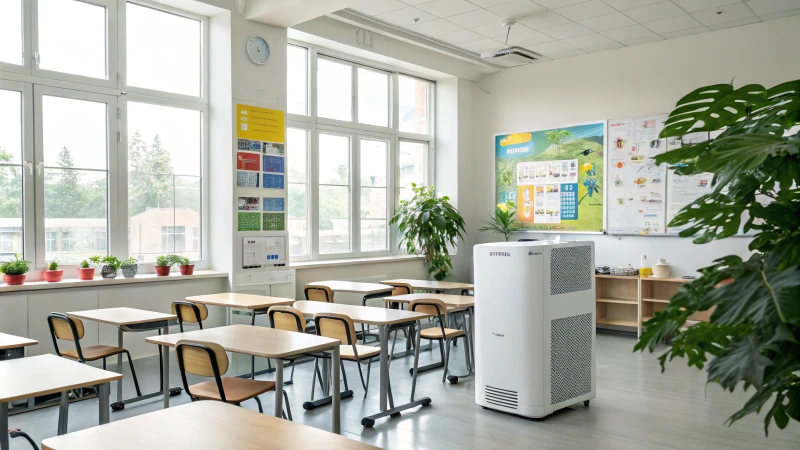
Die Anforderungen an die Luftqualität in Schulen verstehen
Ich erinnere mich, wie ich im letzten Winter das Klassenzimmer meines Sohnes betrat und das Gefühl hatte, dass die Luft nicht frisch war. Viele Kinder, die sich in einem Raum drängen, beeinträchtigen die Luftqualität. Räume in Schulen haben besondere Schwierigkeiten, z. B. viele Menschen und unterschiedliche Raumgrößen. HisoAir's erweiterte Filter5 helfen, indem sie schädliche Partikel entfernen und einen gesünderen Raum zum Lernen schaffen.
Lärmbelästigung in Lernumgebungen
Lärm war eine weitere Sache, die ich sah. Ein alter Luftreiniger machte ein lautes, störendes Geräusch. Die innovative Decibel Cancellation™-Technologie von HisoAir reduziert den Lärm und ist damit ideal für Klassenzimmer, die Stille erfordern6. Ruhige Räume helfen den Schülern, sich besser zu konzentrieren. Klassenräume, die Ruhe brauchen, profitieren sehr von dieser Erfindung.
| Merkmal | Nutzen für Schulen |
|---|---|
| Hohe Filtrationsleistung | Entfernt Allergene, Staub und Krankheitserreger |
| Geräuscharmer Betrieb | Fördert die Konzentration und das Lernen |
| Vielseitige Installation | Kann an der Wand oder an der Decke montiert werden |
Flexibilität bei der Installation
Bei einer Schulbesichtigung sah ich, wie Schüler mit Stehgeräten spielten. Das war besorgniserregend. HisoAir bietet flexible Aufstellungsmöglichkeiten, z. B. die Anbringung der Geräte an der Wand oder der Decke. Dies verhindert Manipulationen durch Schüler und gewährleistet optimale Luftverteilung7 in großen Räumen.
Luftreiniger für Schulen im Vergleich
Schulen müssen bei der Auswahl von Luftreinigern vor allem darauf achten, wie gut die Luft gereinigt wird und wie leise das Gerät ist. Bei der Auswahl eines Luftreinigers für eine Bildungseinrichtung sollten Sie Leistungskennzahlen wie die Luftreinigungsrate (Clean Air Delivery Rate, CADR) und den Geräuschpegel berücksichtigen:
| Marke | CADR | Lärmpegel | Einrichtung |
|---|---|---|---|
| HisoAir | Hoch | Niedrig | Wand/Decke |
| Marke X | Mittel | Mittel | Boden |
| Marke Y | Niedrig | Hoch | Begrenzt |
HisoAir zeichnet sich in diesen Bereichen aus und ist damit die erste Wahl für die Aufrechterhaltung einer effektiven und gesunden Lernumgebung. Ich denke über diese Eigenschaften für die Schule meines Kindes nach, um den Schülern die beste Umgebung zu bieten, die sie verdienen.
HisoAir Luftreiniger sind ideal für Schulklassen.Wahr
HisoAir bietet leistungsstarke, leise, wandmontierte Optionen, die für Schulen geeignet sind.
Für Klassenzimmer reichen normale Haushaltsreiniger aus.Falsch
In Klassenzimmern sind höhere CFM-Werte und eine bessere Geräuschdämmung erforderlich als in typischen Wohnräumen.
Schlussfolgerung
HisoAir-Luftreiniger sind ideal für Schulen und bieten hohe Leistung, geringe Geräuschentwicklung und sichere Wandmontage, um die Luftqualität und die Lernumgebung in Klassenzimmern zu verbessern.
-
Dieser Link untersucht, wie Hintergrundgeräusche die Konzentration der Schüler stören, und bietet Einblicke in den Umgang mit solchen Ablenkungen. ↩
-
Erfahren Sie mehr über die Rolle des Signal-Rausch-Verhältnisses bei der Verbesserung der Akustik im Klassenzimmer für besseres Lernen. ↩
-
Entdecken Sie Methoden zur Einrichtung von Ruhezonen in Schulen, um die Konzentration zu verbessern und die Lärmbelästigung zu verringern. ↩
-
Erfahren Sie, warum HisoAir Luftreiniger ideal für Schulumgebungen sind, und konzentrieren Sie sich dabei auf ihre Leistungs- und Sicherheitsmerkmale. ↩
-
Erfahren Sie, wie fortschrittliche Filterung die Luftqualität verbessert, die für die Reduzierung von Allergenen und Krankheitserregern in Klassenzimmern entscheidend ist. ↩
-
Entdecken Sie, warum die Minimierung des Lärms wichtig ist, um die Konzentration der Schüler aufrechtzuerhalten und die Lernergebnisse zu verbessern. ↩
-
Erfahren Sie, wie wand- oder deckenmontierte Luftreiniger die Luftverteilung verbessern und so Störungen durch Schüler verhindern. ↩






